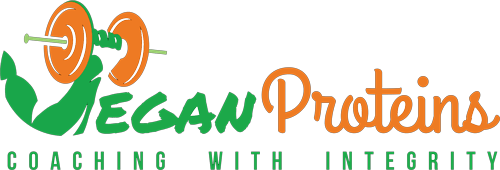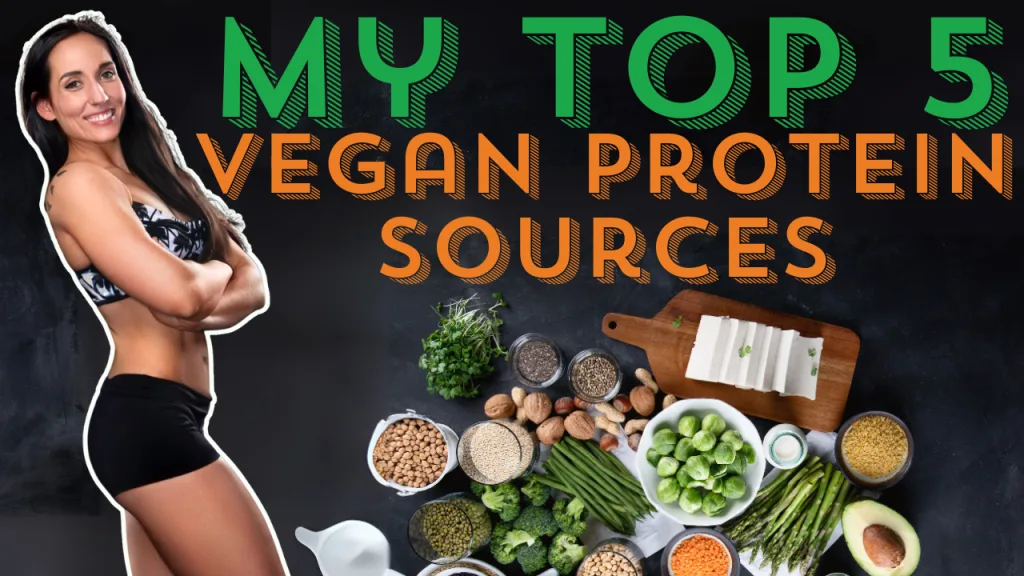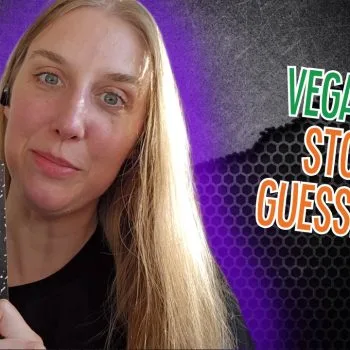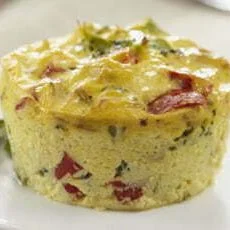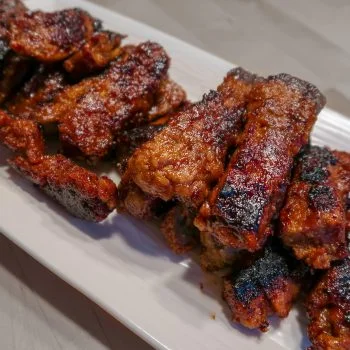https://youtu.be/Bs-nacHyWx8
Looking to boost your protein intake on a vegan diet? Learn about the top 5 vegan protein sources and how they can help with muscle building, fat loss, and overall fitness goals. Whether you’re into bodybuilding or just want to stay healthy, these plant-based powerhouses are perfect for your routine. Find out how to fuel your body without any animal products!
Transcript:
Dani:
Let’s talk protein, specifically vegan protein, because let’s face it, one of the first things that people ask when they hear you’re vegan is where do you get your protein?
…
Dani:
If I had a dollar for every time I heard that, I’d be retired on a beach somewhere by now. If you’re new here, h hi, I’m Dani Taylor, co owner of Vegan Proteins and a vegan figure competitor. Our channel is about helping you build muscle, lose fat and feel your best on a vegan diet without any of the fluff or nonsense. So if that sounds like something you’re into, be sure to subscribe and stick around.
And if you’re serious about leveling up your fitness, we’ve been coaching vegans since 2008 and we would love to help you out. So check out the link below to apply for our one on one coaching. Now, let’s break down my top five vegan protein sources that you need to know about. These are versatile, delicious, and I saved the most controversial, controversial one for last.
Let’s go. First up, we have tofu, the OG of vegan protein. Here, tofu is made from soybeans and it’s been a staple in Asian cuisine for centuries. Not only is it packed with protein, there’s about 40 grams of protein per block of extra firm tofu, but it’s also insanely versatile. While tofu is a little bit higher in fat than some of our other options that we’re going to talk about today, it is very low in carbs.
If that’s something that’s important to you, you can stir fry it, you can bake it, you can blend it into a creamy sauce, you can air fry it, which is my go to, or you can even use silken tofu in desserts and sauces. And here is a secret. I have pressed tofu maybe twice in my 23 years of being vegan. I just don’t think it’s necessary and it just makes it seem like a more fickle ingredient than it actually is.
Also bonus, it’s loaded with calcium and iron as well. This block of tofu has about 6, 600 milligrams of calcium in it and about 20% of your daily iron. Now, I know some people are going to say tofu is bland and tasteless, but so is flour. And we all know the delicious cakes, breads and cookies that can be made from flour. Tofu is the same way. It’s just a blank canvas waiting to take on whatever flavors are in your recipe.
So go ahead and get creative and if you want more tofu recipes or tips, hit the subscribe button. We’ve got a ton of resources to help you out, including a five Ways to Cook Tofu video that I will link in the cards right here. Now I I want to talk about what I’m sure someone is leaving in the comments right now. The elephant in the room. Soy and Hormones.
So some people think that eating soy messes with your hormones. It doesn’t. It has been debunked to death. Soy contains phytoestrogens which are plant based compounds, not human or mammalian estrogen and are actually protective against certain cancers and heart disease. And for the dudes out there that are afraid that they will grow boobs if they eat soy, let me tell you that if soy made boobs grow, it would be the number one selling supplement on earth.
So go ahead and enjoy your tofu and if you want to hear more about that because this would be a very long video if I dove all the way into that. Right now we have a Whole Muscles by Brussels Radio episode on this exact topic. Soy, phytoestrogens, hormones. I’m going to link it right here. If you’ve been avoiding tofu because you think it’s boring or weird, just give it another shot with the right recipe, it is a total game changer.
Seitan. Next up is seitan, or sometimes called wheat meat. So this stuff has also been fueling plant based diets for centuries. It also originated in China where Buddhist monks used it as a meat substitute. Back then it was called Mien Ching, which means Buddha’s food, which I think is pretty cool. Seitan is essentially pure gluten, the protein part of wheat.
So if you’re gluten free, this is not the one for you. But that is also why it is such a protein powerhouse. It has 20 to 30 grams of protein per serving. When you turn the vital wheat gluten into seitan, it gives this really chewy texture which makes it a favorite for anyone that’s missing like a meaty bite to something. It’s really, really versatile.
You can stir fry it, grill it, slice it into sandwiches, or use it in stews and soups. And if you are crafty in the kitchen, like I said, this is homemade. You can make your own seitan at home. It’s really easy. It lets you control the flavor. And this is an absolute go to for me every single day, which I should have started with. Most of these are a go to for me most days of the week.
One more thing. Vital Wheat gluten, which is the ingredient used to make seitan, doesn’t just need to used in savory goods. You can use vital wheat gluten in pancakes baked goods to add a protein punch to some of the sweeter baked goods that you make. But be careful not to try to replace all of your flour with vital wheat gluten, or you will end up with a meaty brick rather than a soft, fluffy pancake.
One quick point. Wheat gluten by itself is low in the amino acid lysine. So some people will say it isn’t a great protein source, which, if that was all you ate, fair. But so many other foods that we eat in abundance each day are really high in lysine, including all beans, quinoa, amaranth, and a lot of other things. You don’t need to eat all of the amino acids at every meal because they all get broken down into individual amino acids in the amino pool, which you can think of as a literal
pool in your body and used as needed to build muscle, repair tissues and make hormones. Our body’s really good at managing this amino acid pool, which is why you don’t need all of the essential amino acids every time you eat. As long as you’re eating a variety of protein sources throughout the day, that pool should stay stock and your body can mix and match the amino acids it needs.
So if you’re having toast, which is low in lysine for breakfast, and lentil soup, which is high in lysine for lunch, it all balances out. Your body doesn’t care if all the amino acids came from the same plate. But if you do want to make your own seitan, a complete protein unto itself, simply add some chickpea flour to the mix or even tofu to your recipe, which is what we did in this one right here.
We do have a recipe on the channel for a five minute single serving seitan that has 40 grams of protein. You can’t beat that. I’ll link it right here. TVP or Textured vegetable Protein. All right, I want to talk about tvp. This one sounds kind of weird, but it’s actually super simple. TVP is made from defatted soy flour originally, and it’s basically ground up and dried into little tiny protein nuggets.
So although it’s traditionally made from soy, in recent years we’ve seen different types of TVP made from peas and other legumes, which is great for people with various allergies. So you can see there are these dry little crunchy bits here. Although you can get bigger chunks. These are probably the smallest chunks you can get. You rehydrate them with water or broth and it turns into a sort of ground beefy kind of texture.
So it’s perfect for tacos, chilies, spaghetti sauce, sloppy joes. And it is crazy affordable and has about 15 to 20 grams of protein per half a cup. My favorite way to use it is to add it to any soup recipe that I already love just with some extra veggie broth. We also have a five minute taco meat recipe on the channel that people love that uses tvp.
I’ll link it right here. TVP is one of those pantry staples that can save you in a pinch when you’re low on thyme and or fresh ingredients. You just make sure to season it well because on its own it kind of tastes like nothing. Some people get really creative with TVP and add it to their oatmeal and other types of sweet meals, or people even just sprinkle it dry on top of their salads as a sort of crouton.
I haven’t done either of those things, but I know other people do now. Someone in the comments is BO to mention that many tvps use a soy flour that is defatted using a chemical process with hexane. So while the hexane is removed from the final product, so I personally have no problem using it. There are companies that use soy flours made from a mechanical process pressing out the oil just like a cold pressed oil so no chemicals involved.
One of the easiest ways to kind of suss that out is generally if it’s an organic tvp, they probably use a mechanical method rather than a chemical one. Protein Powder Protein powder is actually my personal least favorite on this list. I sometimes get praised in my meal prep videos in the comments for rarely using protein powder, but that’s simply because I don’t like the taste of it.
I still recommend them to my clients who do enjoy them because it’s quick, it’s convenient, it’s incredibly versatile. So whether you’re super busy or just want something immediately after training, or you just realize like it’s near the end of the day and you need to add 25 grams to your protein total quick. It is a stupidly simple way to make sure you’re hitting your protein goals for the day.
And I actually wish that I liked it more. If I ever find one that I genuinely give the pass to guys, I will let you know there are tons of options to choose from when it comes to vegan protein, let me tell you, 20 years ago that was not the case. It was soy or bust. Now there’s pea protein, soy protein, hemp protein, rice protein, and blends made from lots of different sources.
Plant fusion, for example, which is what this is. I don’t know why Giacomo de potted it, but it is plant fusion. Plant Fusion makes their classic blend out of pea, amaranth, artichoke and quinoa protein. So you can see like the list of things you can extract protein from is endless. Every protein powder has its own unique texture and flavor, so you gotta find one that you like.
Most vegan protein powders give between 15 and 25 grams of protein powder per scoop, which makes this a duh food. And it doesn’t just have to be used in shakes either. So like blending it with almond milk and a banana is a pretty classic move. And just slamming it with just water is tried and true for any bodybuilder, but you can do a lot more with it.
You can mix it into oatmeal for a protein packed breakfast, you could stir it into plant based yogurt. You can bake it into muffins or pancakes. You can even sneak it into soups and sauces if you have an unflavored variety. So when you’re picking out a protein powder, just find one you like. If you’re new to protein powders or picky about taste, try to buy little sample size packets rather than buying a whole big tub.
And if you guys have one that you really love, I want to hear about it in the comments below because I am still looking for them. I use them on occasion when I’m traveling because they are so convenient, but they are not my favorite. That doesn’t make it not awesome though. Certain mock meats. I told you, I saved the most controversial one for last.
Mock meats are a convenient and really tasty way to add protein to your meals. But it’s really important to know that not all of them are created equal. Brands like beyond and Impossible, which arguably are the most popular mock meats I’ve ever seen in my entire time of being vegan. And I’m grateful for their presence in a lot of different restaurants.
Otherwise a lot of times I would have nothing to eat in certain restaurants. So grateful for them. But they’re not, in my opinion, great choices as a protein source. And I do see a lot of people refer to them as a protein source. I would argue that they’re actually more of a fat source than a protein Source, because most of their calories come from fat, not protein.
So for some better options, I just grabbed a couple things I have here today. Products like the original Boca Burgers, Tofurky Deli Slices, Morningstar Farm Chicken Strips, Daring Chicken Strips, Upton’s Bacon, anything by Abbott’s Butcher. These are packed with protein and are much lower in fat. Most of them are pretty low in carbs. Most of them are very high in protein.
You’ve probably seen me use these in a million videos. Each serving is 140 calories, 3 grams of fat, 5 grams of carbs, 24 grams of protein. They’re pre seasoned, they’re delicious. So one of the reasons that this is so controversial of a take, which is wild to me, is that a common complaint is that mock meats are just junk food or overly processed.
But a lot of mock meats on the market are just a mix of the same protein sources that we already talked about. Tofu, vital wheat, gluten, pea protein, add some spices, some flavorings, shapings. Use various cooking methods and boom, you’ve got yourself a vegan mock meat that’s high in protein. In fact, one of the reasons that we started this channel many years ago was to show you how to make your own mock meats at home.
If you wanted to try to do that for yourself and control more of the ingredients, if that’s important to you, we have lots of those videos on this channel. Another complaint is the high sodium content, which is true. Many of the mock meats do have a higher sodium content, which if you’re an athlete, I’m not particularly worried about. But if it’s something that is of concern to you, make them yourself.
It’s really not that hard. I just showed you the seitan that we made here, so it’s worth the time to learn how to make these yourself. Also, it’ll save you a lot of money. So mock meats are great for people who are transitioning to a plant based diet or just anyone who’s craving something familiar. They’re quick to cook, easy to use in sandwiches, salads, stir fries or tacos.
And unlike beyond and impossible, the options that I mentioned before focus more on protein than on fat or carbs. And while they’re not whole foods, I don’t believe everything we eat needs to be whole food. And a lot of people get stuck in a never ending physique plateau because they are trying to eat 100% whole foods. But that is an entire other video.
So mock meats can be a valuable part of a balanced diet. If you pair them up with whole grains, potatoes, veggies, legumes, fruits, nuts, seeds with so many different plant based mock meat options, you’re gonna find something that you enjoy that helps you hit your protein goals. And I want to say that you can have them guilt free. I promise you that most of the vegan athletes that you look up to are eating one of these on a nearly daily basis.
And if you want to hear me dive more into my love of mock meats, you can watch this video here. And there you have it. My Top five Vegan Protein Sources. If you found this helpful, let me know in the comments and subscribe for more vegan athlete tips, tricks and recipes. And don’t forget, if you’re ready to take your fitness journey to the next level and you’re a vegan, apply for one on one coaching.
Using the link below, we will build you a customized plan to help you crush your goals and guide you every step of the way. Whether that’s building muscle, losing fat, or just feeling more confident in your skin. If you like the video, be sure to like the video. Subscribe. Hit the bell. All the things I’m supposed to tell you to do at the end of a YouTube video and we’ll talk to you soon. Bye.
